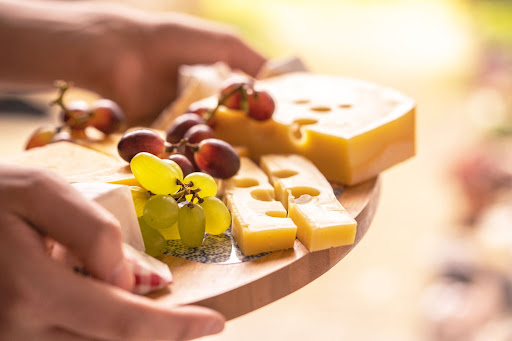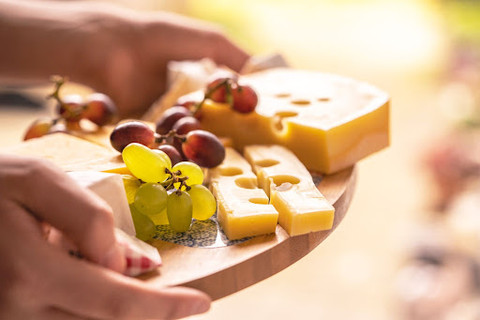Improve The Taste of Homemade Cheese: The Quick Guide
12th Oct 2021

There’s a reason cheese finds its place in a vast variety of cuisines and culinary delights: it’s delicious! While cheese is a remarkable food that many people enjoy, its flavor can grow stale after a while. That may leave you wondering–how can you make cheese taste better?
Some easy ways to make cheese taste better are to make sure it’s the right temperature when you eat it and that you’re pairing it with other foods properly. Another method is to ensure the cheese is made with high-quality ingredients, the best way for which is to make the cheese yourself.
Well then, what exactly is the right temperature to eat cheese? And what foods serve to compliment it best? Don’t worry, we’ll break it down so you know exactly how to bring your cheese to the next level. First, let’s discuss how to choose the best ingredients when making cheese at home.
Better Ingredients Make Better Cheese
Even if you’ve never made cheese before, homemade cheese can easily be the best cheese you’ve ever tasted. Both the freshness and your ability to control the quality of the ingredients make for unmatched flavor. You’ve probably already got most of the equipment to get started anyway, so why not give it a shot? Even if you don’t, one of our cheesemaking kits is a great way to get started. When making your own cheese, here are a few things to consider.
Choosing the right milk for your cheese

Whether it’s traditional or vegan cheese, the most integral ingredient in cheese is milk. It may come in a variety of forms from a variety of sources, but either way it will largely affect the resulting cheese.
While the ideal milk for cheesemaking is non-homogenized/cream-on-top milk, you can make great tasting cheese at home using standard homogenized whole milk. Yet, if you look at the ingredient list for the majority of store bought cheeses, they typically use reduced-fat or fat-free milk. While these varieties of milk may produce a cheese that’s marginally healthier in terms of fat and calorie content, they do so at the expense of flavor. Just be sure you don’t use ultra-pasteurized milk (pasteurized is okay) and you can achieve flavor like you’ve never tasted before.
Cheese cultures and cheese flavor
The science of how cultured cheeses get their flavors is relatively complicated, but for our purposes, you should know that a major contributing factor for aged cheeses’ flavor is the type of culture used in the recipe. Aged cheeses (like blue cheese and camembert) get their signature flavors from very specific cultures that are added before the aging process begins. With that, if there are any impurities in the ingredients, they may taint the resulting cheese. You can rest assured our selection of high-quality cheese cultures will help you achieve great flavor.
Selecting spices

Not all cheeses use spices as part of their recipes (aside from typically salt), but they can be a fun way to shake up stale flavors. If you do choose to incorporate spices in your cheese recipe, just be sure that they are free of microbes or spores that could negatively affect the resulting flavor of your cheese. In the “about this product” section for each of our herbs, you’ll find a microbial analysis that helps you to be sure these ingredients add only flavor, not malevolent hitchhikers.
Some spices to include in your cheesemaking ventures include italian herbs, vanilla beans, and liquid smoke. Additional ingredients you might not be so familiar with include fenugreek seeds, stinging nettle, and food grade edible ash. Well, the ash isn’t used so much to add flavor, but morso to aid in the aging process of cheeses. That is, of course, unless you're the kind of person who likes to burn their marshmallows.
Temperature for Taste & Texture

While refrigeration is imperative for proper cheese storage, you might be surprised to hear that’s not always the best temperature to eat your cheese. In the same way that freezing cold temperatures make cheap liquor more palatable, cold temperatures mute the flavor of cheese. Cold temperatures can also affect the texture of cheese, sometimes for the worse.
What’s the best temperature to eat cheese?
Typically, room temperature or slightly cooler than room temperature is the best temperature to maximize both flavor and texture of cheese (apart from cooked cheeses). A popular example of cheese that’s best consumed at room temperature would be cheese curds. A staple in America’s dairyland, Wisconsin natives stand by room-temperature, squeaky cheese curds. Other cheeses to try at room temperature would include those that are naturally creamy in texture, such as brie or camembert.
Be sure your cheese doesn’t dry out when bringing it up to room temperature. This can be done by either keeping it in the packaging (for store bought cheese) or inverting a bowl over the cheese once you’ve placed it on a cheese board. Just make sure to eat it before it sits out too long, as if that was ever an issue.
Can you freeze cheese?
Of the dairy products destined to be frozen, cheese isn’t one of them. While freezing cheese is a safe way to extend its shelf life, the practice wreaks havoc on cheese’s delicate flavor and texture balance. It’s best to refrain from freezing cheese if it can be avoided. Fresh cheeses are best enjoyed promptly after they are made, but if you must freeze your cheese, we suggest only freezing cheese that’ll be cooked into other dishes. Otherwise, store your cheese in a sealed container in the refrigerator.
Cheese Pairing
A big part of the way you experience your cheese is dependant on the other food you’re combining it with. The best pairing will vary based on the properties of the cheese you’re eating, so there’s no one-side-fits-all. Let’s dig in and see some of the perfect ways to eat your favorite cheeses.
Standalone Cheeses

Some types of cheese don’t need anything to back up their flavor; they’re perfect just as they are. The exact cheeses that fit into this category can be plenty to fill an evening of conversation among cheesemongers, but there are some generally agreeable cheeses that you’ll find here.
These cheeses, like fresh mozzarella and mild cheddar cheese curds, are plenty delicious all by themselves. You can add them to other dishes of course, but their relatively mild flavor is easy to lose in complicated recipes.
Partner Cheeses

These cheeses are the kind you’ll find on charcuterie boards and as significant ingredients in some of your favorite dishes. Their flavor is bold enough to warrant a pairing with other flavors, yet mild enough to not be overpowering.
Sharp cheddar, gouda, camembert, and even cream cheese are all types of cheese that are generally best paired with other ingredients. Cheese and crackers is a common go-to, but you might want to broaden your palate. Try pairing some of these cheeses with sweet and acidic notes; fresh figs or even honey add some sweetness to the naturally savory cheeses while balsamic vinegar or olives can help to break up the fattiness.

Accent Cheeses

Then, there are some cheeses that you’d be hard pressed to simply take a bite out of. These cheeses, like parmesan, romano, and pecorino, are plenty pungent and are best suited for use like a spice. While they may not make up a substantial portion of whatever dish they’re incorporated into, they are often what makes the difference in terms of flavor. Other cheeses that fit into this category are those that undergo an extensive aging process (greater than three months, sometimes years) or those that generally have a fairly bold flavor profile (such as feta).
A Tasty Conclusion
You’ve probably already thought of a few dishes that traditionally include these cheeses, but don’t be afraid to venture out and experiment with these. Instead of using salt on your eggs in the morning, grate a bit of parmesan over them, then plate atop toast with tomato and pesto. You can even add some of these cheeses to your burgers while forming the meat into patties. When you think of these cheeses as a spice, you can let your culinary creativity run wild.

